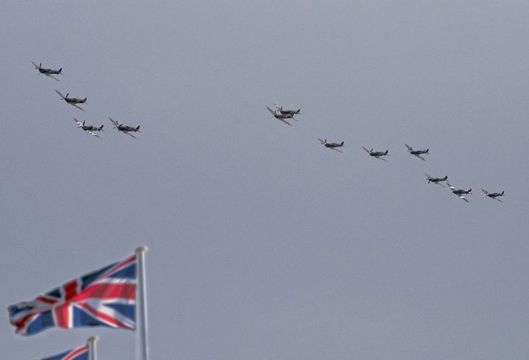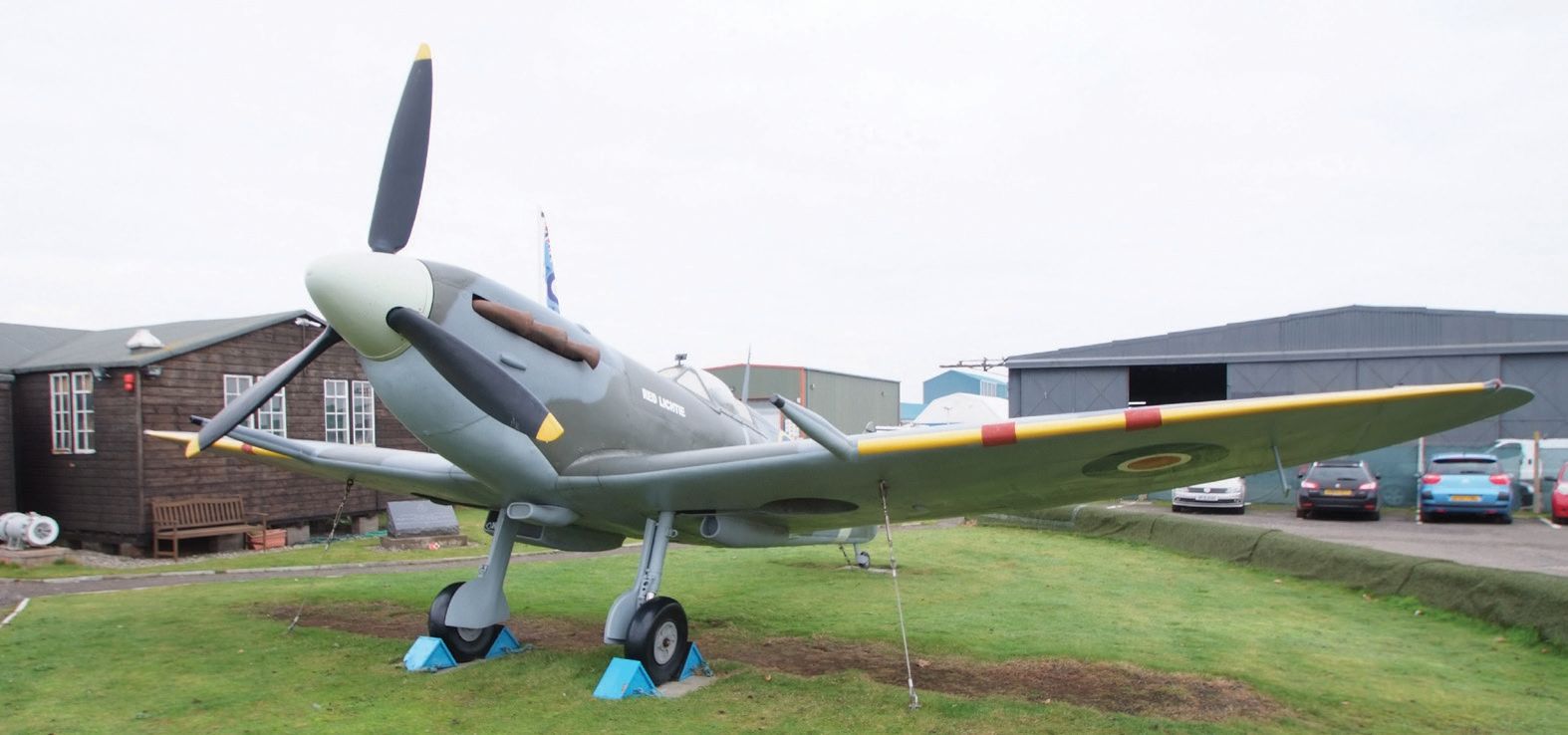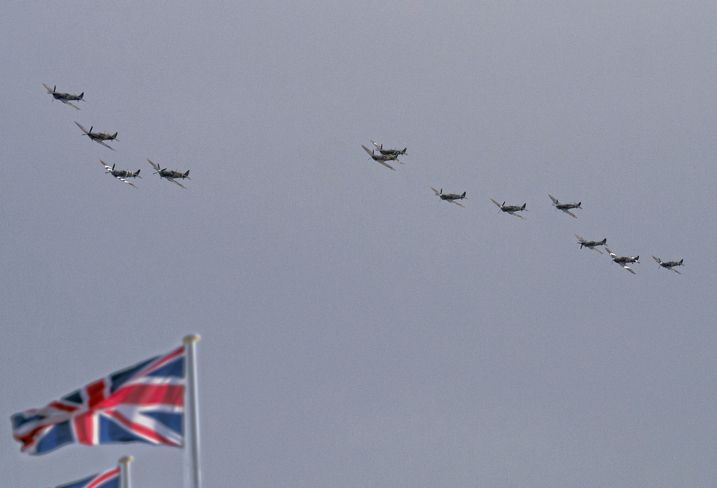
The Royal Air ForceGetty Images
From ghosts to bagpipes and romance to stunt flying, Forbes Inglis looks at the history of UK’s first operational airbase as we celebrate over 100 years of the RAF
The Royal Burgh of Montrose on the east coast of Scotland sits on a spit of land between the North Sea and a tidal basin. The result is a natural harbor which made the town an important trading center as early as the 10th century.
Montrose was certainly a thriving seaport in the days of sail and it is said that Robert the Bruce’s heart was taken from there in the 14th century so that he could ‘take part’ in the Crusades. It’s also said that Old Pretender, James Francis Edward Stuart, who aspired to be James III, sailed from the town in 1716 after his ill-fated attempt to retake the British throne.
Read more: The man who tried to steal the Crown Jewels
A different type of transport
Transport of a different type was pioneered at Montrose when the Royal Flying Corps, the forerunner of the Royal Air Force, set up the first operational airbase in the United Kingdom there in 1913. The idea came from the then First Sea Lord, Winston Churchill, who wanted to prevent German airships spying on the British Fleet at Scapa Flow and Cromarty in the north and Rosyth to the south. Montrose was approximately midway between the naval bases. The Montrose Air Station Heritage Center, set up in 1993, celebrates the history of the air station.

Montrose
The first squadron to be based at Montrose was No 2 Squadron of the Royal Flying Corps, the forerunner of the modern Royal Air Force. No 2 Squadron was the first squadron to fly heavier than air machines, No 1 Squadron flew airships and balloons.
Because of the limited technology of the time, the aircraft, elementary biplanes such as Maurice Farmans and BE2s, made the journey in short hops so it took almost two weeks to fly north from Farnborough in southern England to Montrose.
In those days, pilots often navigated by following railway lines, and the first airman to reach Montrose could not find the airfield so he landed on the grounds of a local hospital. (The noise made the hospital engineer think there was a problem with some of the machinery in the laundry).There, the pilot was given directions and flew to the landing area at Dysart, just south of the town.
That airfield was soon found to be unsuitable and, by the start of 1914, the air station transferred to its present site, on the north side of the town. Those first airstrips were simply grass fields but the new site had the advantage of wooden hangars, Indian Army sheds, later called Burke’s Sheds, after the Commanding Officer of No 2 Squadron, Major James Burke.
No 2 Squadron’s time at Montrose was relatively brief as they were posted to France in August 1914, shortly after the outbreak of WWI. On leaving, they reputedly locked everything up and left a note saying that none of their remaining equipment should be touched until their return. In fact, they never returned to Montrose, although No 2 Squadron remains in existence to this day.
Read more: Explore the Fosse Way
Montrose becomes a training airfield
Being so far from the action, Montrose became a training airfield during the First War, hosting numerous nationalities including Americans and Canadians.
Many members of the RFC, which became the Royal Air Force on April 1, 1918, retained their connections with Montrose, often after marrying local girls. After America entered WWI, a number of US Squadrons were posted to RFC Montrose and at least a dozen US servicemen were so captivated by the local lasses that they also married and took their new wives back to the States, something that we associate more with WWII.
With what people then believed to have been ‘the War to end all Wars’ over there was no need for bases such as RAF Montrose and it closed in 1920.
By the mid-1930s however, it became obvious that the peace had not been won and the Government reluctantly started to prepare for another conflict. As a result of this policy change, the airfield was re-opened in 1936 as No 8 Flying Training School under the command of H V C de Crespigny.
Although he was an Australian, de Crespigny was a pipe band enthusiast and he was responsible for setting up the station pipe band. This resulted in the serving personnel being wakened by the sound of bagpipes rather than bugle calls.
Even from the setting up of the base in 1913, Montrose Town Council had realized the growing importance of flying and they hoped that the town would eventually become a civilian airfield. Sadly, the advent of the jet engine and ever-larger airliners meant that Montrose was unsuitable for this purpose and the Council’s ambitions were never realized.
That said, the Council continued to hope. When Sir Alan Cobham’s Flying Circus, which was touring the country to get people interested in aviation, visited the town between the Wars, he had a positive message for the Council. He told them if you installed a gas pump, windsock, and a telephone you had a civilian airfield. All of the neighboring dignitaries had been invited and the Provost (Mayor) of one of the nearby towns said they would support Montrose’s quest for its own air station until they got their own. He obviously thought air travel would eventually be as commonplace as using buses and trains.
Again the base at Montrose was predominantly used for training pilots, although from 1940 until 1943 there was normally a detachment from a fighter squadron based at Montrose to defend the airfield and the shipping lanes. The skyline of the town is dominated by a 220 feet high church steeple which was used by the pilots of RFC/RAF Montrose as a landmark during both Wars. Unfortunately, in WWII, the airmen of the Luftwaffe did the same and the town was subjected to a number of bombing raids which resulted in both civilian and service fatalities, although not on the scale suffered by the large cities of the UK.
There to meet the intruders at different points were the pilots of auxiliary squadrons, 603 (City of Edinburgh), 602 (City of Glasgow), men who had been hobby flyers before the war but equipped with Spitfires, the top fighter of the time. Later, professional airmen from units such as 111 Squadron replaced them but, irrespective of their background, many of the pilots who went on to take part in the Battle of Britain had their first experience of aerial combat over the east coast of Scotland.
The training itself was a dangerous occupation and more pilots were killed in training than in combat with an average of one fatality each week. Perhaps then, it is hardly surprising that the airfield at Montrose is one of the most haunted places in Britain. At least twelve different apparitions, pilots, planes, and even a black Labrador dog, are said to haunt RFC/RAF Montrose.
Certainly the most famous of these phantoms, and probably the first aviation ghost, is ‘the Montrose Ghost’, generally believed to be Irishman Desmond Arthur, who fell to his death on May 27, 1913, when his plane broke up near the Dysart airfield. An inquiry into the accident decided that the cause of the crash was a faulty wing strut that had been broken and then covered over with a cosmetic repair.
Read More: Surprising nicknames the Royals use with each other

The Royal Air Force
Arthur was given a full military funeral and buried at a local cemetery. In 1916 the inquiry was reopened and the cause of Arthur’s death attributed to stunt flying. It was then that a ghost started to appear at the Officers’ Quarters, presumably trying to lobby his fellow officers to intervene on his behalf. When the original report was rediscovered and Arthur’s name cleared the hauntings stopped.
Among the exhibits on display are a number of planes, actual aircraft, and replicas, refurbished or built by the dedicated band of volunteers who work at the center.
The WWI aircraft include a BE2 and a Sopwith Camel, the top fighting machine on the Western Front during the later years of that conflict. Representing WWII is a replica Spitfire numbered EP121, which bears the colors and markings of 602 Squadron. The original was purchased at a cost of $4,000, raised by the inhabitants of the nearby town of Arbroath during the early 1940s. The people of Arbroath are known as Red Lichties and that was the name given to the aircraft. On June 26 1943, EP121 suffered engine failure and crashed. The plane was deemed to be beyond repair and subsequently scrapped, however, the Canadian pilot, Sgt W H Palmer, survived.
Read more: Harry and Meghan come under fire for their branding
Montrose Air Station Heritage Center
The Montrose Air Station Heritage Center is not just for the aviation enthusiast. It is as much about people as aviation, telling the stories of those who lived, loved, and died at Montrose, as well as featuring the planes they flew and maintained during two World Wars. Exhibits and displays show what life was like for those living on the Home Front with food and clothing rationed, under the shadow of possible bombing raids and, during the early years of WWII, the threat of imminent invasion. At the same time, it honors those who gave their lives in combat or training during the Two World Wars, as well as those killed in the bombing raids on the town and the airfield. The center recounts the history of the base and gives a flavor of the lives of the thousands of men and women who passed through its gates between 1913 and 1950.
For further details about Montrose Air Station Heritage Center see; www.rafmontrose.org.uk





Comments